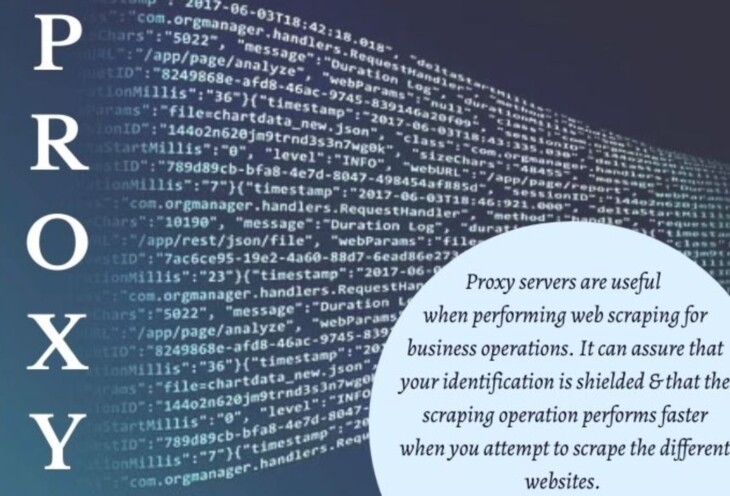Data aggregation is the most straightforward part of any marketing campaign, yet it’s often the most time-consuming. Marketers take hours to research data from various sites and painstakingly compile it into a spreadsheet.
Though it is an essential part of marketing, it doesn’t have to be as difficult. Newer data aggregation platforms and web scraping could help you automate the process, freeing up your time to do other work.
It doesn’t matter if you’re IT savvy or a dinosaur when it comes to technology. These aggregation platforms are made with beginners in mind, so you can master the platform in no time. In this article, we’ll be talking about various business models based on data aggregation and the role of a residential proxy in it.
Contents
How can a residential proxy help your data aggregation business?

Source: ProxiesForrent
When you use a bot for your data aggregation business, your bot will have to visit many sites in a short span of time. This is a red flag for most servers, and it will lead to them blocking your IP address or blacklisting it to prevent any fraudulent activities from taking place.
A residential proxy hides your IP address and the country you’re surfing from and gives you unlimited access to over 40 million residential IP addresses in over 195 countries in the world. This means your bot will be able to send out as many connection requests as it needs to, without any irritating captchas to fill out or IP blocks. Your IP address will be private since you’ll be given a new one with each new request you make. The best part? You won’t experience any slowdowns. Smartproxy has an average response time of 3.1s, so you can enjoy the same surfing experience you had prior to using a proxy.
What is data aggregation, and how does it work?

Source: Import.io
Data aggregation is the process of collecting data from separate sources and organizing it into a database.
The process generally starts with web scraping. This is when large amounts of data are extracted from websites and saved to a local file on a computer. Instead of manually visiting each site and pasting the necessary information onto an excel sheet, a scraper bot could complete it for you in mere minutes. You could either write a program with specific parameters in place or use popular data aggregation software to do this.
Data acquisition and customer tracking are also critical parts of collecting the data you need to begin a project.
Data acquisition refers to measuring what’s happening in the real world and using it internally. For example, a marketer could use a web scraping tool to mine product reviews from sites like Amazon to gather feedback on a common weakness of a product.
Using this information, they could potentially design the perfect product, one that addresses every aspect of their customer’s pain points.
Customer tracking refers to keeping track of a customer’s preferences and using them to improve your products. A clothing company using customer return and purchase information would be an excellent example of this.
Data collection can be done on clothing items that are returned and purchased so marketers can determine what items people keep returning. Marketers then observe the type and size of clothes a customer buys from retailer A and type and size of clothes they buy from retailer B.
With this new information, marketers can adjust their current product lineup to fit all the customer’s needs, leading to more sales and greater customer satisfaction.
Let’s take a look at a few business models that use data aggregation and can greatly benefit from automating the process.
Business Model #1: Flight Aggregators

Source: Remote Year
Flight aggregators search for travel deals across websites and display these results on their sites.
In a sense, they act as a search engine for flights and hotel bookings. They start by collecting and aggregating data from thousands of travel service providers. They source their inventory of flights and hotels by liaising with these companies directly or by using global distribution systems (GDS). They then proceed to list them on their site, where their users can compare them. There are a few differences between the flight aggregation business model and the others in this list.
Firstly, these sites usually book accommodations in bulk. For example, if they wanted to offer 30 hotel rooms in Spain on their site, they would contact a hotel and purchase the rooms from them, at $100 a night. They then proceed to upsell the rooms to their customers at $125 and make a profit of $25.
For flights, these sites will contact a budget airline and reserve a fixed number of seats at a discounted price. They’re usually able to negotiate discounts with the airlines since they’re buying in bulk. Afterwards, they’ll proceed to upsell their clients once again.
Don’t forget that these prices don’t include other add-ons for short flights like meals, extra legroom, priority boarding, et cetera.
Business Model #2: Property Listing Aggregators

Source: Learning Hub | G2
These refer to sites that pool together houses that are ready to be sold. Most of these sites also provide information like the pricing of the homes, the addresses of the houses, the seller’s contact information and details of surrounding amenities like public transport.
This makes it significantly easier for buyers, who don’t have to wait for ads or hunt down a seller’s contact information independently.
Business Model #3: Financial Aggregation

Source: Investopedia
Financial platforms use data aggregation so users can see all of their information in one place. Users first consent to the software accessing their checking accounts and any other accounts by providing their usernames and passwords. The software then proceeds to “scrape” the data from each of these sources and compile it onto a single page, where it can be viewed easily.
For security purposes, most financial aggregation software cannot make transactions. They can only view the earning and spending history of the account.
This presents numerous benefits to users, especially to those who have joint accounts with their families. Parents and children will be able to see the progress of retirement and saving for college on the same page, providing the family with a complete picture of their financial health.
Another advantage of using financial aggregation software is convenience. Instead of juggling multiple tabs and spreadsheets to find out how much they’ve spent or earned that month, users only need to view a single page that will inform them of everything they need to know.
In summary
Data aggregation software is a valuable tool in the business world and can handle most of your research needs. Finding a good data aggregation platform that meets your needs is essential to seeing the results you want in the workplace.
